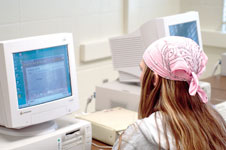Speeding students open books, prepare for classroom settings

Melissa Adamson, freshman business major, works on her speed reading assignment in the Learning Center computer lab.
By the time most readers will finish this sentence, some students who have taken the speed reading class at Missouri Southern will be halfway done with the story.
Dr. Jan Holmes, associate professor of teacher education, said the class is designed to work with the individual student.
“We start at the speed the student is at when they come in,” Holmes said. “Some people are reading at 250 words; some people are reading at 300 words. The first session we get a baseline reading rate, and depending upon where they start, we try to work to doubling that speed.”
The students work at different paces because they each came in reading at a different rate. Each student has a folder where they record their progress.
The class first meets in a classroom in the Learning Center where they are taught about eye movement or oral fixations. The students then do a timed text reading. After the text reading they move to the computer lab. In the computer lab the class uses the software “Ultimate Speed Reading.” When the student begins the software, they start with an eye movement exercise.
“It’s (the eye movement exercises) like stretching before a game,” she said.
After the stretches the students move onto newspaper reading. This is where they are timed on how fast they can read in columns, either one or two columns. The students then move onto paced reading.
Holmes said paced reading is where the computer changes the page, even if the student has not finished reading the page.
After the paced reading the students can go onto a timed reading, where they can control page movement.
Holmes said she is not for sure how long Southern has had a speed reading class, but said it was an interim class for a while.
“It was approved for a regular class and we started doing it every spring,” she said.
The class meets for 10 sessions, twice a week for five weeks, is a pass/fail class and is worth one hour of credit. Holmes said she teaches the class this way because she does not want the students to be threatened by a grade.
“I don’t want people, when they’re trying to increase their speed worrying about a grade,” she said. “They will risk reading faster and exploring different techniques to use without a threat of a grade. If I had a grade on it, people would be like ‘What do I have to do to get an A?’ That isn’t this course.”
Holmes said the class is goal oriented. The students will set a goal and hope to achieve it by the end of the five weeks, if the goal needs to be adjusted before then “it will be modified along the way.” Paul Carter, sophomore pre-med major, said he enjoys the course because of the way it is designed.
“It’s (the class) very well designed to increase the difficulty and to make you read faster,” Carter said. “You have to start reading faster. It automatically speeds it up for you.”
“I think it’s a good idea,” said Stephanie McLaughlin, junior undecided major. “I think it helps people speed up their reading, for slower readers to get it up to the main speed.”
Students who take the class take it for several different reasons. Holmes said students take the class because they read slowly “they actually lost comprehension.”
“I’m a slow reader,” Carter said. “The amount of reading I have to do, I’ve got to do something to get it done.”
Some students take the class to help them with readings for other classes. Aimee Julian, junior dental hygiene major, said she believes the class is helping her with her reading for other classes. She said she is improving in her reading for other classes.
“(I’m taking the class) to help my other classes, like my history classes,” McLaughlin said. “To read faster and to get a better grade.”
Some people seem to think when one learns how to speed read they are constantly reading at 900 words per minute. Holmes said this is not true.
“It (speed reading) means you have the ability to select various items to read quickly,” she said. “You can be flexible. Some items you may have to read slower, but when the situation warrants it you are able to read faster because you have learned the technique.”
Your donation will support the student journalists of Missouri Southern State University. Your contribution will allow us to purchase equipment and cover our annual website hosting costs.



























